JUICE: SWI arrives in Toulouse
On the same day as the spacecraft, JUICE’s instrument SWI has arrived in Toulouse where the final preparations for the journey to Jupiter will take place. Launch is one year from now.
The Submillimetre Wave Instrument (SWI), which will embark on a research mission to the Jovian system next year aboard ESA’s Jupiter Icy Moon Explorer (JUICE), has reached an important milestone. After eight years of development and construction at the Max Planck Institute for Solar System Research (MPS) in Germany, the instrument arrived yesterday at Airbus Defence and Space in Toulouse, France. At the same time, another, much larger new arrival was welcomed there: the spacecraft itself, which traveled by plane. Over the next few months, JUICE will be prepared in Toulouse for its launch into space; integration of SWI into the space probe will begin in a few weeks. In the Jovian system, the instrument from MPS will study Jupiter's atmosphere and some of its life-friendly moons.
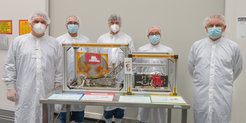
For the giant gas planet Jupiter, “visitors” from Earth a nothing new: the space probes Voyager 1 and 2, Cassini and New Horizons flew past Jupiter on their way to the outer solar system, the American space probe Galileo was on site from 1995 to 2003, and NASA's Juno probe has been orbiting the planet for five years. JUICE will arrive in 2031. With its ten powerful instruments, the spacecraft will be able to look more closely and comprehensively than its predecessors - not only at the planet itself, but also at Ganymede, Callisto, and Europa, three of its largest moons. JUICE will analyse the ultraviolet, visible and infrared radiation in the Jovian system, make geophysical measurements, determine magnetic properties and study the high-energy particles surrounding the planet and its moons.
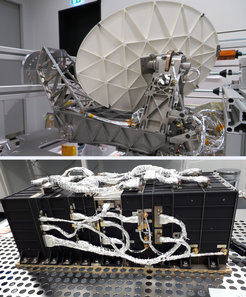
Some of the scientific instruments, such as the Particle Environment Package (PEP), to which the MPS contributed the Jovian Electron and Ion Sensor (JEI), have already been integrated into the spacecraft at ESA's European Space Research and Technology Center (ESTEC) in the Netherlands, where JUICE was tested in the past years. Other instruments are only now being added after the spacecraft's move to Toulouse. These include SWI, which a team of more than 40 scientists and engineers led by the MPS has developed, built, and tested for space suitability in recent years. „The entire team worked very hard to assemble and qualify SWI flight hardware for working in Jupiter's extreme environment with the last part of the efforts taking place throughout the Covid19 pandemic”, Dr. Ali Ravanbakhsh, SWI Assembly, Integration, Verification and Test Manager, says.
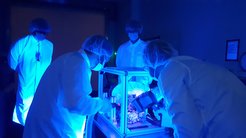
The instrument studies the thermal radiation in the far infrared emitted into space by Jupiter and its moons and breaks it down into its individual wavelengths. In the case of the gas giant, this radiation originates primarily in its middle atmosphere, allowing comprehensive access to this dynamic and complex region. The SWI data from Jupiter will include information on the chemical composition, trace gases, temperature distribution and wind speeds of the atmosphere. For the moons, with their distinctly thin atmospheres, some of the radiation comes from the surface. This will allow the SWI team to track, among other things, the distribution of water on these moons from the surface to the atmosphere.
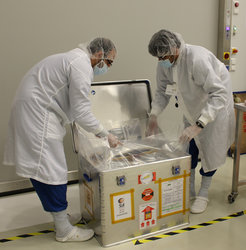
"The water in the Jovian system is of particular interest to us," explains MPS scientist Dr. Paul Hartogh of the MPS, SWI Principal Investigator. SWI can determine the exact ratio of semiheavy water, in which a hydrogen atom is replaced by a heavier hydrogen isotope, to "normal" water. This ratio is considered an indicator of where in the solar system a body originated. "Our studies help to understand how Jupiter, with its 80 moons and numerous rings, was able to evolve into the unique world it is today," says MPS scientist Dr. Miriam Rengel. Scientists consider Jupiter a model system for the numerous similar gas planets outside our solar system.
To capture the infrared radiation, SWI has a swiveling antenna with a diameter of 29 centimeters that resembles a small satellite dish. The antenna and the receiver unit will be located outside of the probe. They are connected to the electronics unit inside the probe via cables.
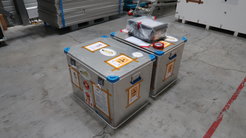
"One of the things that makes SWI special is its very high spectral resolution," Hartogh said. The instrument can distinguish between radiation of very closely neighboring wavelengths. To achieve this, the SWI team relies on what is known as the heterodyne principle: by superimposing a reference wave the frequency of the received signal is shifted into the classical radio range, where further signal processing takes place.
It will be years before SWI takes its first measurements. After launch next June, JUICE will travel through space for almost nine years before it reaches its destination. On the way, several flybys of Earth and one flyby of Venus are scheduled.
For the SWI team at MPS, the wait certainly won't be boring. "For now, we've earned a breather," says SWI Project Manager Juan Pablo Garcia of MPS. "But from mid-September, when SWI will be integrated into the spacecraft, we will be back on site in Toulouse to lend a hand," he adds. And even after that, work will continue. That's when the SWI flight spare unit will be created at MPS, an identical twin to the flight unit now delivered, which will remain at MPS as a reference for the duration of the mission.
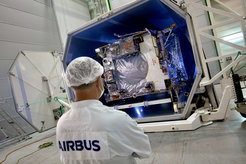
SWI has been developed and built by an international consortium of institutes led by the Max Planck Institute for Solar System Research (MPS, Germany) and including the Laboratory for Studies of Radiation and Matter in Astrophysics (LERMA, France), the Space Research Centre of the Polish Academy of Sciences (CBK, Poland), Chalmers University of Technology (Sweden), the Institute of Applied Physics of the University of Bern (IAP, Switzerland), the National Institute of Information and Communications Technology (NICT, Japan) and the French Space Agency CNES with additional support from the Laboratoire d’études spatiales et d’instrumentation en astrophysique of the Observatoire de Paris (LESIA, France), the Laboratoire d'Astrophysique de Bordeaux (LAB, France), the RPG Radiometer Physics GmbH (Germany), and Omnisys Instrument AV (Sweden). This development has been supported by national funding agencies including DLR (Germany).

















